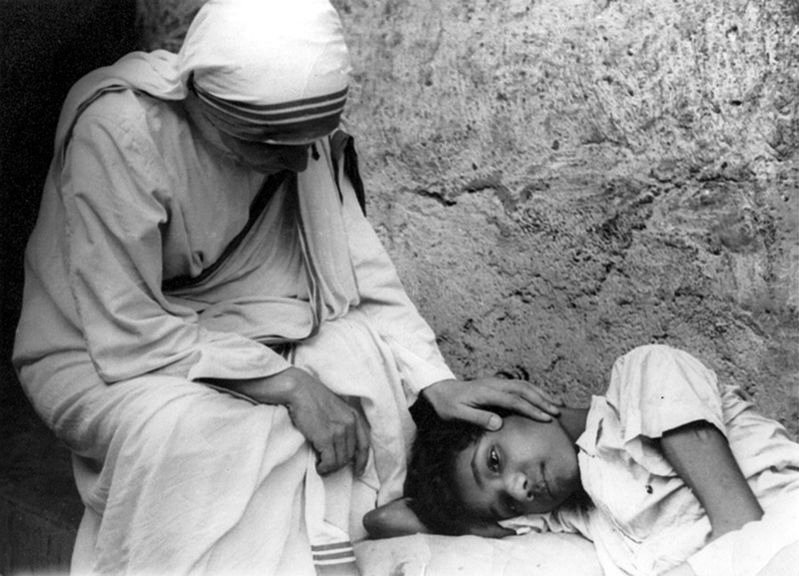Despite feeling God’s absence during long periods of her life, she never lost faith
Earlier this month the Catholic Church celebrated 25 years of Mother Teresa of Calcutta’s sainthood on her feast day on 5 September.
That she is a saint is a fact pretty much universally accepted, even outside the Catholic Church. Among the hordes of secular media, the Economist, in particular, waxed lyrical about the petite South-eastern European native. It is unusual because the news fraternity doesn’t normally have a fondness for religious figures or groups, much less Christianity.
Born on 26 August 1910 in Skopje, Mother Teresa started helping the poor, destitute and hungry in the slums of India while on a retreat in Calcutta in 1946. A group of young women joined her and four years later she founded the Missionaries of Charity dedicated to this work. Her religious congregation expanded around the world and today has over 5,000 sisters continuing her mission among the poor.
Despite her dedication to the destitute and dying, there was a minority few who were fiercely vocal against the canonisation of the naturalised Indian nun who died on 5 Sept 1997. And they did not only come from leading New Atheist figures such as Christopher Hitchens and Richard Dawkins but from some prominent Catholic commentators as well.

Why were they critical of her?
A likely reason is what she wrote in the book, Mother Teresa: Come Be My Light. In it, the saint disclosed that throughout a long period in her life, she had felt a great distance between her and God. This flew in the face of most people’s perception of saints. In the popular imagination, they are thought to be people with halos around their heads to signify their closeness to God. They are supposed to walk in His presence and favour all the time. Perhaps, they are even supposed to see visions of angels!
The dark night of the soul
Instead, Mother Teresa seemed to be confessing to some sort of spiritual emptiness. Literally, the absence of God in her life! What, then, was behind her impassioned speeches and works of charity? Were they spiritual frauds?
There is a tradition in the Church to understand and explain this: it is the Dark Night of the Soul – a stage of spiritual purification where the Christian feels that God is severely absent from her or his life. An example is Job in the Old Testament. He was an extremely upright and virtuous man, and yet subjected to torments as though God was not present in his life. Scripture does not tell us how long his dark night lasted, but it seems to have been long enough for his wife to give up faith in God and for his friends to regard it as something serious. That is, it lasted for more than a single night.
The term “dark night” is not a reference to chronological time. It is a reference to the Bible verse that “weeping endures only in the night, and joy comes in the morning” (Psalms 30: 5). In Mother Teresa’s case, the dark night seems to have lasted for her entire adult life.
Saint John of the Cross described this concept in his poem Dark Night of the Soul. According to the mystic, it is a stage of purgation or purification of a soul from sin. It is when the sinner is exposed fully to how sinful and far away from God he is that he can make the path to heavenly virtue. As the saying goes, God reveals to redeem. There are two stages in this purgation: the physical stage which deals with appetites for material goods and the spiritual stage, which deals with spiritual tendencies.
The dark night of the soul is when God withdraws all spiritual and physical consolations from a person so that the Almighty refiner’s fire can work on him. God makes the person feel as if he has been abandoned by Him. However, the best analogy is to imagine that there is a river between God and the person, and the Lord is cheering for the subject to swim over to Him. And this is the last hurdle, like the final boss on a video game level.
The dark night of the soul does not occur at the beginning of a faith journey. It happens when a person is reaching the end of one level of a relationship.

One of the Canterbury Tales, the Clerk’s Tale, tells of a man, who, after being impressed by his wife’s fortitude, decides to test her. First, he removes their children by pretending to kill them and then finally decides to divorce his wife and marry a younger girl. When she takes all this in submissive stride, he finally relents and reveals the younger girl is in reality their daughter. Divorce and remarriage are, therefore, shams. This allows the wife to ascend into the next stage of the husband’s affections.
God does not abandon a soul
In the same way, this is what a dark night of the soul is. It is God’s issuing a final ordeal before a person achieves the status of saint. Without undergoing it, there is no justification to stand before the Throne of God.
Because the dark night of the soul is primarily a spiritual phenomenon, a person can still be strong enough, as Mother Teresa was, to do supreme acts of charity. The purpose of the dark night, after all, is to strengthen and not destroy the soul. This is unlike depression, which is a tool of the Devil to destroy the spirit.
This explains how Mother Teresa could still be so inspiring to others even while supposedly being distant from God. This is because He was still in her, even though to her, it seems this was not the case.
Far from being fraudulent, Saint Teresa of Calcutta was experiencing a closeness to God that most people can only dream of. Her experience proves to us, as believers, the true degree of her sanctity while still living on Earth.
It is something we all should aspire to.
